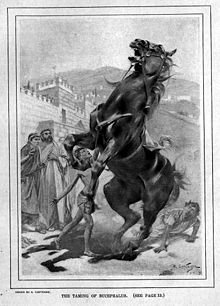André Castaigne: Difference between revisions
Mike Hayes (talk | contribs) |
Mike Hayes (talk | contribs) |
||
| Line 22: | Line 22: | ||
* {{commons-inline}} |
* {{commons-inline}} |
||
*[http://www.illustration-art-solutions.com/andre-castaigne.html Jean André Castaigne at Illustration Art Solutions] |
*[http://www.illustration-art-solutions.com/andre-castaigne.html Jean André Castaigne at Illustration Art Solutions] |
||
*[http://www.unz.org/Author/CastaigneAndre Works of André Castaigne] |
|||
{{Persondata <!-- Metadata: see [[Wikipedia:Persondata]]. --> |
{{Persondata <!-- Metadata: see [[Wikipedia:Persondata]]. --> |
||
Revision as of 00:24, 31 January 2012


Jean André Castaigne (7 January 1861,[1] Angoulême, Charente[2] – 1929, Paris) was a French artist and engraver, a student of Jean-Léon Gérôme and Alexandre Cabanel. Subsequently he became a leading illustrator in the United States. He is often recalled as the original illustrator of the first edition of The Phantom of the Opera.
Castaigne also created more than 36 art pieces about Alexander the Great for an 1898–99 series.[3] He was also one of the illustrators who captured the images of the first modern olympics. He drew pictures of the 1896 Olympic Games for Scribner's Magazine.
Biography
André Castaigne was the son of Jean Eusèbe Joseph Castaigne (b. 1828) und Mathilde Debouchaud. In 1878, he began his studies at what was then the Académie Suisse.[4] After a few months he transferred to the Académie des Beaux-Arts where his two mentors taught. He was in Cabanel's studio for a year before moving to Gérôme's studio where he won first place in the General Competition three times–for nude figure painting, composition, and general excellence.[4] His work was selected for the Prix de Rome on three occasions and, although he never won, it was a compliment as only ten paintings were selected for the competition.[4] He had his first exhibition in Paris in 1884, from where his painting Dante et Béatrice went on tour to New Orleans where it received a great deal of attention. In 1887 he exhibited the huge painting, five yards by four, The Deluge, which later was placed in the municipal gallery of his native city Angoulême. In 1888, he painted a portrait of the Vicomte de Dampierre in his hunting jacket and in 1889 he created a painting titled After the Combat, which later was acquired by the Peabody Gallery in Baltimore.

He spent six months in England, then went to the United States in 1890 and remained until 1894. He became director of an art school in Baltimore called the Charcoal Club and under his direction the school, which had been in decline, flourished and became one of the best art schools in the region.[4] He painted several notable portraits the first year he was in America. He tyravelled to Washington, Chicago, Indianapolis, Detroit, Buffalo, Boston, New York and Philadelphia and in 1891 began the illustrating work by which he is best known to the American public. His first work of this type was The Forty-Niners' Ball in the Century Magazine for May 1891. These images of the West earned him immediate recognition as a master of a very American art form.[4] After that he illustrated for several of the leading magazines. His designs included pictures of Texas cowboys in Scribner's Magazine and the World's Fair drawings and illustrations for 'Polly' in the Century Magazine. He illustrated B.I. Wheeler's Life of Alexander the Great (1900), for which he did over 36 paintings and drawings from November 1898 to October 1899. His work for Century Magazine included travelling extensively, visiting Corsica, Greece and the Rhineland to illustrate travel articles by Augustine Birrell.[4] For The Century he did over 160 illustrations. He also worked for Harper's Magazine from 1901 to 1913.
On his return to France in 1894, he became instructor in the Académie Colarossi and opened a studio in Paris. He published Fata Morgana, a novel dealing with the art life of Paris and illustrated by himself (1904).[2] During a six-year period in France where he divided his time between a winter-studio in Paris and a summer-studio in Angoulême, he illustrated William Milligan Sloane's The Life of Napoleon Bonaparte, Richard Whiteing's Paris of To-Day and Bertha Runkle's The Helmet of Navarre.[1]
While in France, Castaigne was principal draughtsman to the President of France Félix Faure who awarded him the Red Ribbon of the Legion of Honour.[1]
References
- ^ a b c "André Cataigne Revisits America on a Government Mission" (23 March 1901) The New York Times [1]
- ^ a b The Encyclopedia Americana Vol.5 (1918) The Encyclopedia Americana Corp., New York
- ^ Andre Castaigne Biography
- ^ a b c d e f The Critic Vol. XXIII p.57 (July 22, 1893) The Critic Co., New York (Digitized by Google Books)
External links
 Media related to André Castaigne at Wikimedia Commons
Media related to André Castaigne at Wikimedia Commons- Jean André Castaigne at Illustration Art Solutions
- Works of André Castaigne
